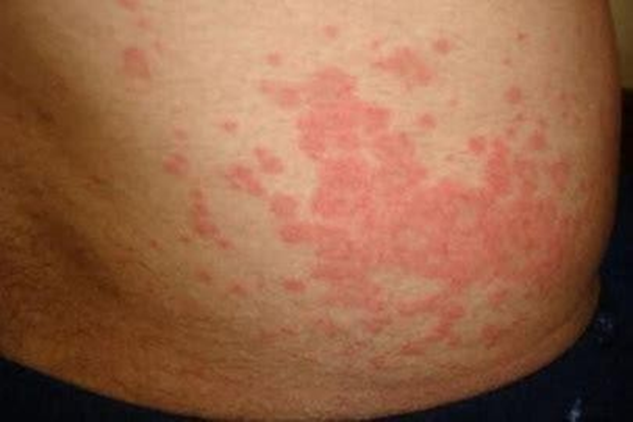A nurse is caring for a client who has a prescription for ceftriaxone. The nurse should monitor the client for which of the following adverse effects?
Constipation
Maculopapular rash
Pitting edema
Concentrated urine
The Correct Answer is B
B. Maculopapular rash is a potential adverse effect of ceftriaxone. It is a type of skin rash characterized by flat, red areas (macules) and raised, bumpy areas (papules). If a client develops a rash while taking ceftriaxone, it should be reported to the healthcare provider for evaluation.

A. Constipation is not a common adverse effect of ceftriaxone. It is more commonly associated with other medications or medical conditions unrelated to ceftriaxone.
C. Pitting edema is not a common adverse effect of ceftriaxone. It may occur as a result of other medical conditions or medications, but it is not specifically associated with ceftriaxone.
D. Concentrated urine is not a common adverse effect of ceftriaxone.
Nursing Test Bank
Naxlex Comprehensive Predictor Exams
Related Questions
Correct Answer is A
Explanation
A. Increased respiratory rate is a sign that naloxone is effectively reversing opioid-induced respiratory depression. Opioids can suppress the respiratory drive, leading to hypoventilation or respiratory arrest. Naloxone works by competitively binding to opioid receptors and displacing opioids, thereby restoring normal respiratory function.
B. Increased temperature is not a direct effect of naloxone administration. Naloxone primarily reverses the central nervous system depressant effects of opioids, including respiratory depression and sedation, rather than affecting body temperature.
C. Naloxone does not directly affect pain perception. Its primary action is to reverse the respiratory depression and central nervous system depression caused by opioids. While the client may experience pain relief indirectly as a result of improved respiratory function and consciousness, naloxone itself does not directly reduce pain.
D. Decreased blood pressure is not a direct effect of naloxone administration. Naloxone primarily reverses the respiratory and central nervous system depressant effects of opioids, rather than affecting blood pressure directly.
Correct Answer is A
Explanation
A. Garlic may potentiate the effects of warfarin, an anticoagulant medication. When taken together, garlic can increase the risk of bleeding due to its antiplatelet properties, potentially leading to an increased risk of bruising or bleeding episodes.
B. Hydrochlorothiazide is a diuretic medication used to treat hypertension and edema. There is no known significant interaction between hydrochlorothiazide and garlic.
C. Dicloxacillin is an antibiotic medication from the penicillin class. There is no known significant interaction between dicloxacillin and garlic.
D. Esomeprazole is a proton pump inhibitor (PPI) used to reduce stomach acid production. There is no known significant interaction between esomeprazole and garlic.
Whether you are a student looking to ace your exams or a practicing nurse seeking to enhance your expertise , our nursing education contents will empower you with the confidence and competence to make a difference in the lives of patients and become a respected leader in the healthcare field.
Visit Naxlex, invest in your future and unlock endless possibilities with our unparalleled nursing education contents today
Report Wrong Answer on the Current Question
Do you disagree with the answer? If yes, what is your expected answer? Explain.
Kindly be descriptive with the issue you are facing.
